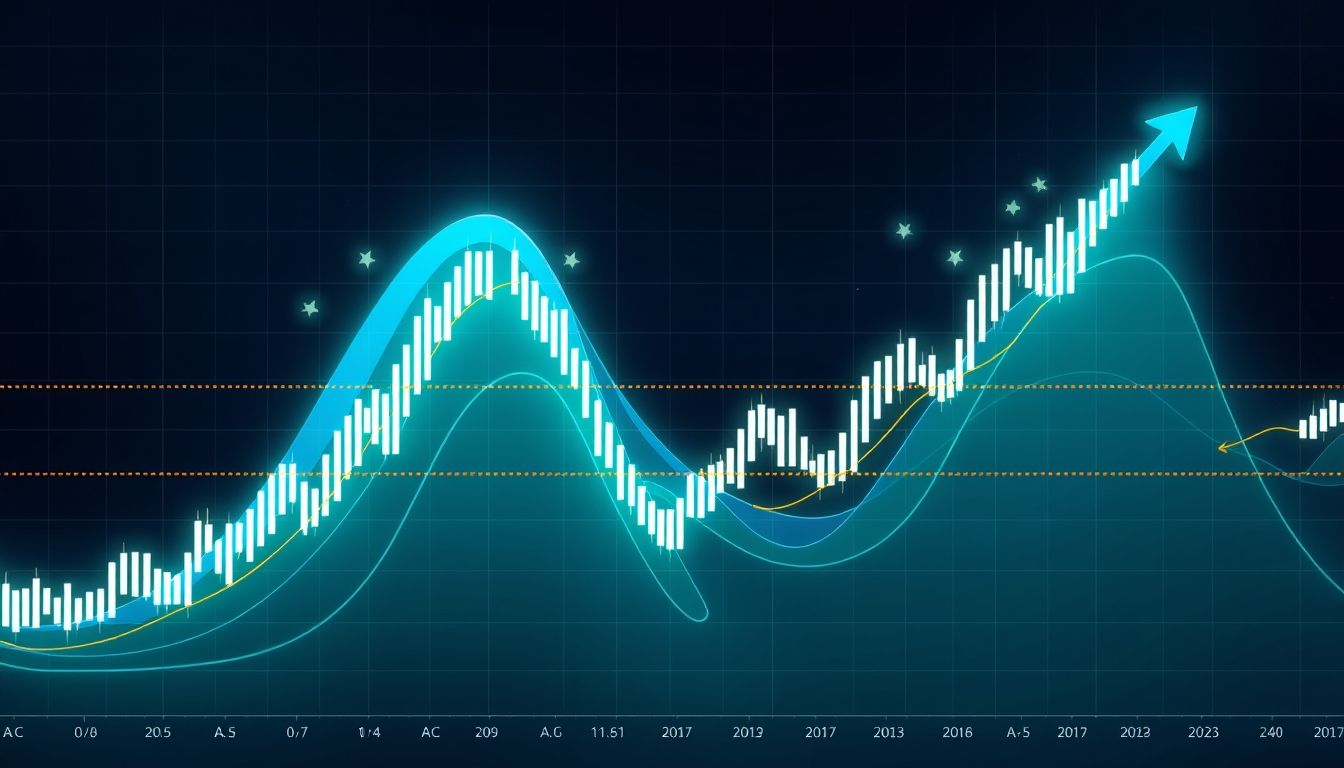مقدمة إلى نظرية موجات إليوت
نظرية موجات إليوت هي أسلوب تحليل فني يستخدم لتوقع حركة أسعار الأسواق المالية. تعتمد النظرية على فكرة أن الأسواق تتحرك في أنماط موجية محددة، تعكس سيكولوجية المستثمرين الجماعية. تأسست هذه النظرية على يد رالف نيلسون إليوت في ثلاثينيات القرن الماضي، وتعتبر اليوم أداة قيمة للمتداولين والمستثمرين في جميع أنحاء العالم.
ما هي موجات إليوت؟
تتكون موجات إليوت من نمطين أساسيين: الموجات الدافعة والموجات التصحيحية. الموجات الدافعة تتكون من خمس موجات تتحرك في اتجاه الاتجاه الرئيسي، بينما الموجات التصحيحية تتكون من ثلاث موجات تتحرك عكس الاتجاه الرئيسي.
- الموجات الدافعة (Impulse Waves): تتكون من خمس موجات (1، 2، 3، 4، 5) وتتحرك في اتجاه الاتجاه الرئيسي. الموجة 3 عادة ما تكون الأطول والأقوى.
- الموجات التصحيحية (Corrective Waves): تتكون من ثلاث موجات (A، B، C) وتتحرك عكس الاتجاه الرئيسي، وتصحح جزءًا من المكاسب التي حققتها الموجات الدافعة.
الفصل الأول: أساسيات نظرية موجات إليوت
لفهم نظرية موجات إليوت بشكل كامل، يجب أن نتعمق في مفاهيمها الأساسية وأنماطها المتكررة. هذه الأسس تساعد المتداول على تحديد الموجات بشكل صحيح وتوقع حركات الأسعار المستقبلية.
قواعد موجات إليوت الأساسية
- الموجة 2 لا يمكن أن تتجاوز نقطة بداية الموجة 1.
- الموجة 3 لا يمكن أن تكون الأقصر بين الموجات الدافعة (1، 3، 5).
- الموجة 4 لا يمكن أن تتداخل مع منطقة سعر الموجة 1.
النسب الذهبية (Fibonacci Ratios) ودورها في موجات إليوت
تلعب النسب الذهبية، وخاصة نسبة 61.8% و 38.2% دورًا حاسمًا في تحديد مستويات التصحيح المحتملة وأهداف الأسعار. غالبًا ما تستخدم النسب الذهبية لتحديد نقاط الدخول والخروج المحتملة.
مثال: إذا كانت الموجة 1 قد ارتفعت بمقدار 100 نقطة، فقد نتوقع أن تصحح الموجة 2 بنسبة 61.8% من هذه الحركة، أي حوالي 61.8 نقطة.
الفصل الثاني: تحديد الموجات الدافعة والتصحيحية
القدرة على تحديد الموجات الدافعة والتصحيحية بدقة هي مفتاح النجاح في التداول باستخدام نظرية موجات إليوت. يتطلب ذلك فهمًا عميقًا للأنماط الموجية وقواعدها.
كيفية تحديد الموجات الدافعة
الموجات الدافعة هي الموجات التي تدفع السعر في اتجاه الاتجاه الرئيسي. يجب أن تتبع القواعد الأساسية لموجات إليوت، بما في ذلك عدم تجاوز الموجة 2 لنقطة بداية الموجة 1، وعدم كون الموجة 3 الأقصر، وعدم تداخل الموجة 4 مع منطقة سعر الموجة 1.
كيفية تحديد الموجات التصحيحية
الموجات التصحيحية هي الموجات التي تصحح جزءًا من المكاسب التي حققتها الموجات الدافعة. تتكون عادة من ثلاث موجات (A، B، C). يمكن أن تتخذ الموجات التصحيحية أشكالًا مختلفة، مثل الزجزاج والمسطحة والمثلثات.
مثال: في سوق الأسهم السعودي، إذا رأينا ارتفاعًا قويًا في سهم معين (الموجة الدافعة)، فإننا نتوقع بعد ذلك فترة تصحيحية (الموجة التصحيحية) قبل استئناف الارتفاع.
الفصل الثالث: أنواع الموجات التصحيحية
تتخذ الموجات التصحيحية أشكالًا مختلفة، ولكل شكل خصائصه المميزة. فهم هذه الأشكال يساعد في توقع سلوك السعر المستقبلي.
الزجزاج (Zigzag)
الزجزاج هو أبسط أنواع الموجات التصحيحية ويتكون من ثلاث موجات (A، B، C). الموجة A تتحرك عكس الاتجاه الرئيسي، والموجة B تصحح جزءًا من الموجة A، والموجة C تتحرك في اتجاه الموجة A وتتجاوز نهايتها.
المسطحة (Flat)
المسطحة هي موجة تصحيحية تتكون من ثلاث موجات (A، B، C) حيث تكون الموجة B قريبة من مستوى بداية الموجة A، والموجة C قريبة من مستوى نهاية الموجة A.
المثلثات (Triangles)
المثلثات هي موجات تصحيحية تتكون من خمس موجات تتحرك بشكل متقارب لتشكل شكل مثلث. يمكن أن تكون المثلثات متقاربة أو متباعدة.
الفصل الرابع: استخدام النسب الذهبية في التداول
النسب الذهبية هي أداة قوية لتحديد مستويات الدعم والمقاومة المحتملة، وأهداف الأسعار، ونقاط الدخول والخروج المحتملة. تعتبر النسب الذهبية جزءًا لا يتجزأ من نظرية موجات إليوت.
تصحيحات فيبوناتشي (Fibonacci Retracements)
تستخدم تصحيحات فيبوناتشي لتحديد مستويات الدعم والمقاومة المحتملة. يتم حساب هذه المستويات عن طريق تطبيق النسب الذهبية (23.6%، 38.2%، 50%، 61.8%، 78.6%) على حركة سعرية سابقة.
مثال: إذا كان سعر سهم قد ارتفع من 100 ريال إلى 150 ريال، يمكن استخدام تصحيحات فيبوناتشي لتحديد مستويات الدعم المحتملة عند 138.2 ريال (23.6%)، 130.9 ريال (38.2%)، و 125 ريال (50%).
امتدادات فيبوناتشي (Fibonacci Extensions)
تستخدم امتدادات فيبوناتشي لتحديد أهداف الأسعار المحتملة. يتم حساب هذه الأهداف عن طريق تطبيق النسب الذهبية (61.8%، 100%، 161.8%) على حركة سعرية سابقة.
مثال: إذا كانت الموجة 1 قد ارتفعت بمقدار 50 نقطة، يمكن استخدام امتدادات فيبوناتشي لتحديد أهداف الأسعار المحتملة عند 50 نقطة (100%) و 80.9 نقطة (161.8%).
الفصل الخامس: استراتيجيات التداول باستخدام موجات إليوت
بعد فهم أساسيات نظرية موجات إليوت والنسب الذهبية، يمكن تطوير استراتيجيات تداول فعالة لتحقيق الأرباح.
استراتيجية التداول مع الاتجاه (Trend Following)
تعتمد هذه الاستراتيجية على التداول في اتجاه الاتجاه الرئيسي. يتم الدخول في صفقات شراء عندما تبدأ الموجة 3، والخروج عندما تقترب الموجة 5 من نهايتها.
استراتيجية التداول العكسي (Counter-Trend Trading)
تعتمد هذه الاستراتيجية على التداول عكس الاتجاه الرئيسي. يتم الدخول في صفقات بيع عندما تبدأ الموجة التصحيحية (A، B، C)، والخروج عندما تقترب الموجة C من نهايتها.
إدارة المخاطر في التداول باستخدام موجات إليوت
إدارة المخاطر هي جزء أساسي من أي استراتيجية تداول ناجحة. يجب تحديد حجم الصفقة ومستوى وقف الخسارة وجني الأرباح قبل الدخول في أي صفقة.
مثال: يمكن تحديد مستوى وقف الخسارة أسفل مستوى الدعم مباشرة، وتحديد مستوى جني الأرباح عند مستوى المقاومة المحتمل.
الفصل السادس: أمثلة عملية من السوق العربي والعالمي
لتوضيح كيفية تطبيق نظرية موجات إليوت في التداول، سنستعرض بعض الأمثلة العملية من السوق العربي والعالمي.
تحليل سهم أرامكو باستخدام موجات إليوت
يمكن استخدام نظرية موجات إليوت لتحليل حركة سعر سهم أرامكو وتوقع اتجاهاته المستقبلية. على سبيل المثال، إذا رأينا نمطًا موجيًا دافعًا قويًا، فقد نتوقع استمرار الارتفاع في السعر.
تحليل مؤشر MSCI العالمي باستخدام موجات إليوت
يمكن استخدام نظرية موجات إليوت لتحليل حركة مؤشر MSCI العالمي وتوقع اتجاهاته المستقبلية. على سبيل المثال، إذا رأينا نمطًا موجيًا تصحيحيًا، فقد نتوقع فترة من التراجع أو التذبذب.
الفصل السابع: الأخطاء الشائعة في التداول باستخدام موجات إليوت
يقع العديد من المتداولين في أخطاء شائعة عند استخدام نظرية موجات إليوت. تجنب هذه الأخطاء يمكن أن يحسن بشكل كبير من نتائج التداول.
تحديد الموجات بشكل خاطئ
أحد الأخطاء الشائعة هو تحديد الموجات بشكل خاطئ. يجب التأكد من أن الموجات تتبع القواعد الأساسية لموجات إليوت وأن الأنماط الموجية واضحة.
عدم استخدام النسب الذهبية بشكل صحيح
النسب الذهبية هي أداة قوية، ولكن يجب استخدامها بشكل صحيح. يجب التأكد من تطبيق النسب الذهبية على الحركات السعرية المناسبة واستخدامها لتحديد مستويات الدعم والمقاومة المحتملة وأهداف الأسعار.
عدم إدارة المخاطر بشكل فعال
إدارة المخاطر هي جزء أساسي من أي استراتيجية تداول ناجحة. يجب تحديد حجم الصفقة ومستوى وقف الخسارة وجني الأرباح قبل الدخول في أي صفقة.
الفصل الثامن: أدوات وموارد لمساعدة المتداولين
هناك العديد من الأدوات والموارد المتاحة لمساعدة المتداولين في تطبيق نظرية موجات إليوت.
برامج التحليل الفني
هناك العديد من برامج التحليل الفني التي توفر أدوات لتحديد الموجات ورسم النسب الذهبية. بعض هذه البرامج تشمل TradingView و MetaTrader.
المواقع والمنتديات المتخصصة
هناك العديد من المواقع والمنتديات المتخصصة في نظرية موجات إليوت حيث يمكن للمتداولين تبادل الأفكار والتحليلات. بعض هذه المواقع تشمل Elliott Wave International و Elliott Wave Theory.
الفصل التاسع: نصائح لتحسين مهارات التداول باستخدام موجات إليوت
لتحسين مهارات التداول باستخدام موجات إليوت، يجب الاستمرار في التعلم والممارسة.
الممارسة المستمرة
الممارسة المستمرة هي المفتاح لتحسين مهارات التداول. يجب تحليل الرسوم البيانية وتحديد الموجات ورسم النسب الذهبية بانتظام.
التعلم من الأخطاء
الجميع يرتكب أخطاء في التداول. يجب التعلم من الأخطاء وتجنب تكرارها في المستقبل.
البقاء على اطلاع دائم بأخبار السوق
يجب البقاء على اطلاع دائم بأخبار السوق والأحداث الاقتصادية التي قد تؤثر على الأسعار.
الفصل العاشر: مستقبل نظرية موجات إليوت في الأسواق المالية
تظل نظرية موجات إليوت أداة قيمة للمتداولين والمستثمرين في جميع أنحاء العالم. على الرغم من وجود بعض الانتقادات، إلا أن النظرية تستمر في التطور والتكيف مع التغيرات في الأسواق المالية.
التطورات الحديثة في نظرية موجات إليوت
تتضمن التطورات الحديثة في نظرية موجات إليوت استخدام الذكاء الاصطناعي والتعلم الآلي لتحسين دقة التوقعات.
تأثير التكنولوجيا على تطبيق نظرية موجات إليوت
تتيح التكنولوجيا للمتداولين الوصول إلى المزيد من البيانات والأدوات، مما يسهل تطبيق نظرية موجات إليوت واتخاذ قرارات تداول أفضل.
خلاصة: نظرية موجات إليوت أداة قوية لتحليل الأسواق المالية، ولكنها تتطلب فهمًا عميقًا وممارسة مستمرة. من خلال تطبيق هذه النظرية بشكل صحيح، يمكن للمتداولين تحسين قراراتهم الاستثمارية وزيادة أرباحهم.



